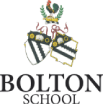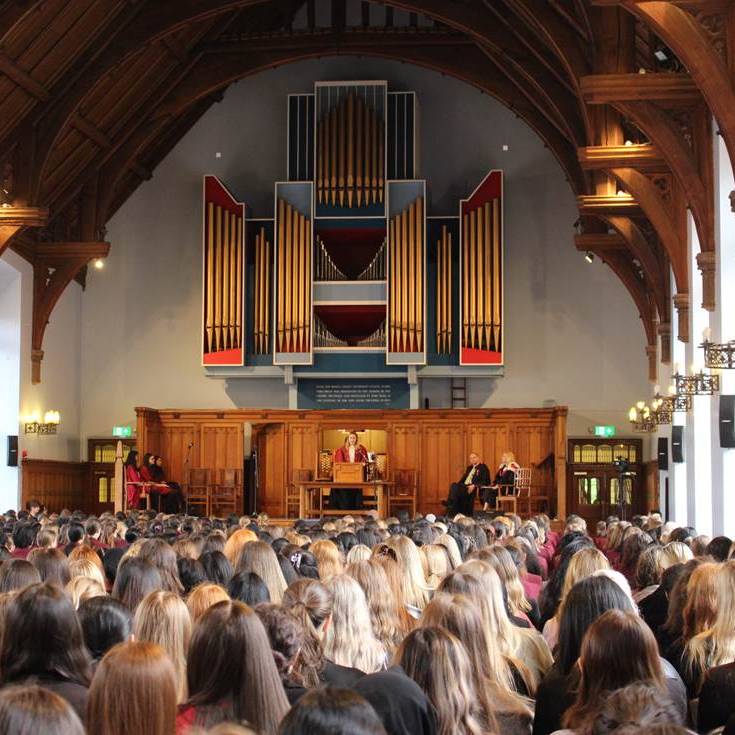
The Girls’ Division for the first time joined the Boys’ Division in holding a Founders and Benefactors Assembly to honour the many figures in Bolton School’s history who have helped to create and shape the school into the Foundation that exists today. The Boys’ Division has been holding this celebration annually since the school’s 100 and 500 anniversary celebrations in 2016.
Head of Foundation Mr Philip Britton led the Founders and Benefactors Assemblies in both Boys’ and Girls’ Divisions.
As this was the inaugural event in the Girls’ Division, Mr Britton began by explaining that this assembly happens on or close to 7 May to commemorate the date of the death of one of Bolton School’s foremost benefactors: Lord Leverhulme. The flags were also flown in his honour during the week of the Founders and Benefactors Assemblies.
Mr Britton went on to note the long and distinguished history of the Foundation, which stretches back to the founding of a school for boys in Bolton in 1516. Since then, the schools that became the Boys’ and Girls’ Divisions have been refounded on a number of occasions. This year the Boys’ Division assembly focused on 1644, during the first Civil War, when Robert Lever reendowed the school with a gift in his will.
However, the most significant date for the Girls’ Division is the founding of Bolton’s first girls’ school in 1877. Mr Britton invited a number of girls to speak at the podium, to give context to this period.
The girls spoke about the wider world in 1877, which coincidentally was also a Jubilee year: the Ruby anniversary of Queen Victoria’s ascension to the throne. It was also the year which saw ‘Black Beauty’ published, ‘Swan Lake’ performed for the first time, and the first test match between England and Australia. At the time, Bolton was a boom town, with buildings springing up along Chorley New Road and Chorley Old Road and industry thriving; but with great wealth came increased wealth gaps and great poverty.
Mary Haslam, whose husband was a governor of the boys’ school and who was also involved in the Women’s Suffrage movement, was one of the key figures involved in the founding of Bolton Girls’ Day School in 1877. Initially located at the Mechanics Institute and employing just one schoolmistress, it was notably open to all girls, regardless of their class. Bolton Girls’ Day School quickly became Bolton High School for Girls and in 1891 moved to a site on Park Road, where the Junior Boys’ School stands today. This school would go on to join with Bolton Grammar School for Boys in 1915 to become the Girls’ and Boys’ Divisions of Bolton School.
Looking back, Mr Britton drew out a few important themes, the first of which was the disgrace that a girls’ school was established so recently in our history, some 361 years after a school for boys. He also reiterated the importance of Mary Haslam, who decided to do something about the inequality she saw around her in Victorian England. With a group of friends, both men and women, she created a school for girls at this pivotal moment of change in the country’s history.
In both assemblies, the audience was invited to join in with singing ‘Jerusalem’ and the School Song: in the Boys’ Division ‘Forty Years On’, and in the Girls’ Division ‘If God Build Not The House’, which was commissioned for the 80th Anniversary, paraphrasing Psalm 127 and with music written by a local composer.
Mr Ford, the Head of Boys’ Division, and Mrs Kyle, the Head of Girls’ Division, also offered up a few words celebrating the enormous contribution that teachers at Bolton School have made to the school’s pupils. In the Girls’ Division, Mrs Kyle also led the assembly through the School Prayer.
The Head Girl and Boys’ Division Captain both spoke at their respective assemblies, giving thanks on behalf of the pupils for those who have contributed to the school: John Barton, the Benefactor who first founded the school for boys in Bolton; Robert Lever, whose benefaction led to the Civil War refoundation of the boys’ school in 1644; Mary Haslam, whose vision with others founded Bolton’s school for girls in 1877; William Hesketh Lever, Lord Leverhulme, who is largely responsible for the current 1915 Foundation and buildings of the school; and many others through the years.
Mr Britton closed both assemblies by bidding Year 13 a fond farewell and wishing them luck in their upcoming A Level examinations.



.jpg&command_2=resize&height_2=85)



















